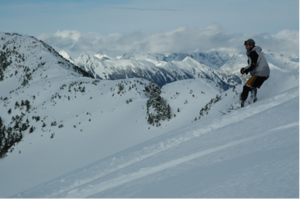
Snowboards are boards where the user places both feet, usually secured, to the same board. The board itself is wider than most skis, with the ability to glide on snow. Snowboards widths are between 6 and 12 inches or 15 to 30 centimeters. Snowboards are differentiated from monoskis by the stance of the user. In monoskiing, the user stands with feet inline with direction of travel, whereas in snowboarding, users stand with feet transverse to the longitude of the board. Users of such equipment may be referred to as snowboarders. Commercial snowboards generally require extra equipment such as bindings and special boots which help secure both feet of a snowboarder, who generally ride in an upright position. These types of boards are commonly used by people at ski hills, mountains, backcountry, or resorts for leisure, entertainment, and competitive purposes in the activity called snowboarding.

Snowboarding is a recreational and competitive activity that involves descending a snow-covered surface while standing on a snowboard that is almost always attached to a rider's feet. It features in the Winter Olympic Games and Winter Paralympic Games.
Boardsports are active outdoor sports that are played with some sort of board as the primary equipment. These sports take place on a variety of terrains, from paved flat-ground and snow-covered hills to water and air. Most boardsports are considered action sports or extreme sports, and thus often appeal to youth. Some board sports were marginalized in the past. However, many board sports are gaining mainstream recognition, and with this recognition, they have enjoyed wider broadcast, sponsorship and inclusion in institutional sporting events, including the Olympic Games.

A terrain park or snow park is an outdoor recreation area containing terrain that allows skiers, snowboarders and snowbikers to perform tricks. Terrain parks have their roots in skateparks and many of the features are common to both.
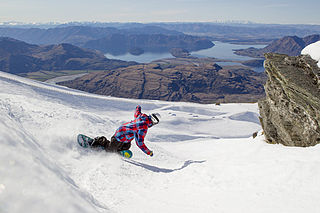
Treble Cone is the closest ski area to Wānaka, New Zealand.
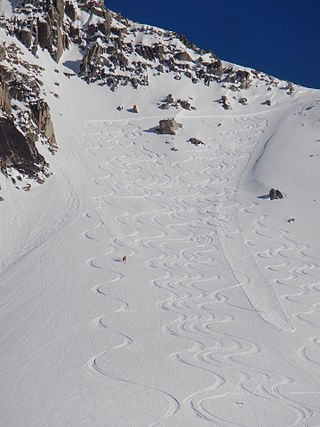
Backcountry skiing (US), also called off-piste (Europe), alpine touring, freeriding or out-of-area, is skiing in the backcountry on unmarked or unpatrolled areas either inside or outside a ski resort's boundaries. This contrasts with alpine skiing, which is typically done on groomed trails benefiting from a ski patrol. Unlike ski touring, backcountry skiing can - and often does - include the use of ski lifts including snowcats and helicopters. Recent improvements in equipment have increased the popularity of the sport. As the sport does confront the individual practicing it with the dangers of natural, unprepared alpine terrain like avalanches, it is generally recommended to carry standard safety equipment and to learn beforehand how to behave safely under such conditions.

Tubing, also known as inner tubing, bumper tubing, towed tubing, biscuiting, or kite tubing, is a recreational activity where an individual rides on top of an inner tube, either on water, snow, or through the air. The tubes themselves are also known as "donuts" or "biscuits" due to their shape.
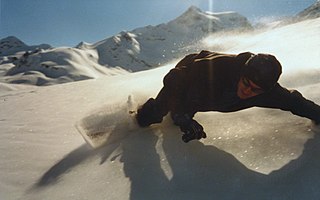
Freeriding is a style of snowboarding or skiing performed on natural, un-groomed terrain, without a set course, goals or rules. It evolved throughout the sport's formative early years as a contrary response to the highly regimented style of ski competition prevalent at the time. Snowboarders primarily refer to freeriding as backcountry, sidecountry, or off-piste snowboarding, and sometimes big mountain or extreme riding.

A splitboard is a snowboard that can be separated into two ski-like parts used with climbing skins to ascend slopes the same way alpine touring or telemark skis are. The main difference is that a splitboard will have an additional metal edge for extra grip in ski mode. Unlike normal snowboards, it will also have nose and tail clips, split hooks, and touring mounts. Similar to cross country skiing, splitboarding allows free heel movement and with skins attached to the bottom of the skis, provides uphill traction. The two halves can then be connected to form a regular snowboard for descent. Splitboarding culture often focuses on the idea of using your own power to access the backcountry usually on unmaintained trails.

Big White Ski Resort, simply known as Big White, is a ski resort located 56 km (35 mi) southeast of Kelowna in the Southern Interior of British Columbia. It is located on Big White Mountain, the highest summit in the Okanagan Highland, an upland area between the Monashee Mountains and the Okanagan Valley. Big White is the third largest resort in British Columbia, after Whistler-Blackcomb and Sun Peaks. In 2019, Big White was nominated as the third-best ski resort in Canada by Snowpak.

Banff Sunshine Village is a ski resort in western Canada, located on the Continental Divide of the Canadian Rockies within Banff National Park in Alberta and Mount Assiniboine Provincial Park in British Columbia. It is one of three major ski resorts located in the Banff National Park. Because of its location straddling the Continental Divide, Sunshine receives more snow than the neighbouring ski resorts. The Sunshine base area is located 15 km (9 mi) southwest of the town of Banff. By car, it is about a ninety-minute drive from the city of Calgary; the Sunshine exit on the Trans Canada Highway is 8 km (5 mi) west of the town of Banff.

Heli-skiing is off-trail, downhill skiing or snowboarding where the skier reaches the top of the mountain by helicopter, instead of a ski lift.
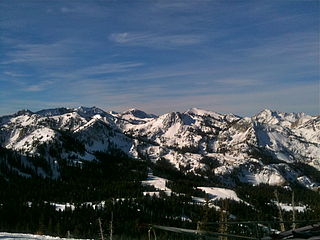
Brighton Ski Resort is a ski area in the western United States, located in Big Cottonwood Canyon in Brighton, Utah. About thirty miles (50 km) from downtown Salt Lake City, it is owned and operated by Boyne Resorts.

June Mountain ski area is a winter resort in the eastern Sierra Nevada of California, located near June Lake, southeast of Yosemite National Park.

A tree well, also known as a spruce trap, is the space around a tree under its branches that does not get the same amount of snow as the surrounding open space. This creates a void or area of loose snow below the branches and around the trunk that is dangerous to any hikers, snowshoers, skiers, snowboarders, and snowmobilers who fall into them. If someone lands in such a well, often as a result of a fall, it can be too deep for them to climb up the surrounding loose snow before they are buried. Making the situation more dangerous, they often fall into the well head-first and as the result of an accident which could leave them injured or unconscious.

Nicolas Müller, is a Swiss snowboarder noted for his smooth riding style and his ability to read different terrains and adjusting his riding to the terrain. Muller's distinguished career and ability has led many critics and riders to hail him as one of the greatest snowboarders of all time. Muller has been voted TransWorld Snowboarding's Rider of the Year on two occasions and was also Snowboarder Magazine's Rider of the Year in 2013.
Some Snowboard binding rotating devices are designed to minimize the torque force that occurs when a snowboarder has one foot out of the binding and one locked on the board. The rotating device allows the snowboarder to turn the locked foot straight into the direction of the tip of the snowboard without removing their boot from the boot binding. Like this they can push themselves forward like a skateboarder. Others are designed to be free rotating the entire time you ride. Both feet are free to turn and adjust to the optimal position for a certain terrain. These subtle changes in foot position help keep stress off of ones knees as well as help ones control down the slopes.
Silverton Mountain is a ski area near Silverton, Colorado, United States that opened on January 19, 2002. Popular with skiers and snowboarders, Silverton Mountain has one chairlift that carries visitors into its terrain, which is for advanced and expert skiers or riders. Avalanche gear is required to ride the lift at all times due to the unpatrolled and ungroomed nature of Silverton. In addition to Silverton Mountain's 1,819 acres of lift accessed skiing, Silverton also serves as a base area for over 22,000 acres of helicopter accessed skiing. Uniquely, Silverton is only open Thursday through Sunday from December through April.
This glossary of skiing and snowboarding terms is a list of definitions of terms and jargon used in skiing, snowboarding, and related winter sports.

Jones Snowboards is a snowboard, snowboard binding, and snowboarding clothing & accessories manufacturer based near Lake Tahoe. The company was founded by renowned freeride snowboarder Jeremy Jones. The company has received numerous awards for its snowboards. Jones snowboards are manufactured in Dubai.
